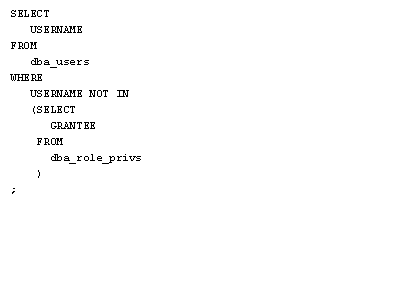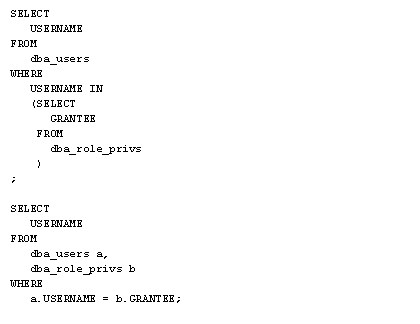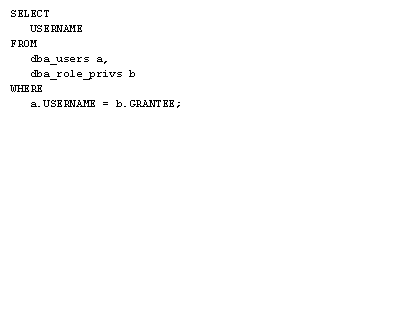| Lesson 7 | Reading non-correlated subqueries |
| Objective | Identify non-correlated Subqueries in Oracle |
Identify non-correlated Subqueries in Oracle

SELECT USERNAME FROM dba_users WHERE USERNAME NOT IN (SELECT GRANTEE FROM dba_role_privs )The body of the select statement simply selects the username from dba_users. In the WHERE clause, we select username where there is not a matching row in the dba_role_privs table. Non-correlated subqueries are almost always used with NOT IN predicates in the WHERE clause. It is never a good idea to perform a non-correlated subquery with the IN clause because a regular table join is more efficient.

SELECT
USERNAME
FROM
dba_users
WHERE
USERNAME IN
(SELECT
GRANTEE
FROM
dba_role_privs
);
To illustrate, let us reverse the NOT IN condition from the prior query and change it to an IN Clause.
Now we see the following identical queries below.

SELECT USERNAME FROM dba_users a, dba_role_privs b WHERE a.USERNAME = b.GRANTEE;
As we can see, the second query is easier to understand, and it will run much faster than the non-correlated subquery.
- The body of the select statement simply select the username from dba_users
- Let us reverse the NOT IN condition from the prior query and change it to an IN Clause
- The second query is easier to understand, and it will run much faster
Non-correlated Subquery
select author_last_name from author where author_key not in (select author_key from book_author);
This type of "NOT IN" subquery is called a non-correlated subquery because the subquery does not make any references to the outside query. We can sometimes re-write a non-correlated subquery into a correlated subquery.
Non-correlated subquery:
select
data1
from
tablename
where
key IN
-- noncorrelated subquery
(select
other_data1
from
inner_table
);
Here is the correlated subquery equivalent. Note the reference in the inner query to the column value in the outer query:
select
data2
from
tablename
where
key IN
-- correlated subquery
(select
other_data2
from
inner_table
where
tablename.key = inner_table.key
);
Always replace a non-correlated subquery that has the IN condition with a standard table join.
The next lesson examines index range scans.
The next lesson examines index range scans.